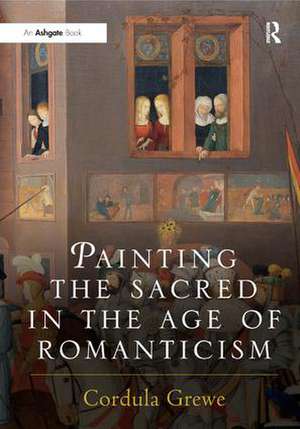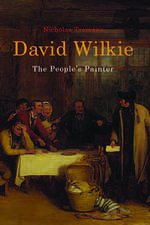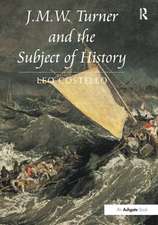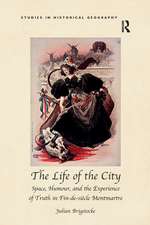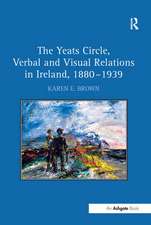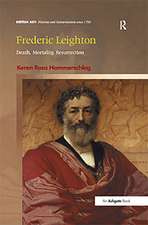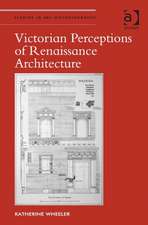Painting the Sacred in the Age of Romanticism: Histories of Vision
Autor Cordula Greween Limba Engleză Hardback – 21 oct 2009
Preț: 861.99 lei
Preț vechi: 1148.81 lei
-25% Nou
Puncte Express: 1293
Preț estimativ în valută:
164.97€ • 171.77$ • 139.42£
164.97€ • 171.77$ • 139.42£
Carte tipărită la comandă
Livrare economică 10-24 martie
Preluare comenzi: 021 569.72.76
Specificații
ISBN-13: 9780754606451
ISBN-10: 0754606457
Pagini: 436
Dimensiuni: 174 x 246 x 33 mm
Greutate: 1.25 kg
Ediția:1
Editura: Taylor & Francis
Colecția Routledge
Seria Histories of Vision
Locul publicării:Oxford, United Kingdom
ISBN-10: 0754606457
Pagini: 436
Dimensiuni: 174 x 246 x 33 mm
Greutate: 1.25 kg
Ediția:1
Editura: Taylor & Francis
Colecția Routledge
Seria Histories of Vision
Locul publicării:Oxford, United Kingdom
Cuprins
Contents: Introduction; the great code of art: religious revival and the rebirth of pictorial meaning; Sulamith and Maria: erotic Mariology and the cult of friendship; Pietas and Vanitas: gender, moralization and allegory; The Seven Sacraments: romantic subjectivity and Catholic dogma; The Bible in Pictures: history lessons and popular culture; A family tree of German art: avant-garde, anti-Judaism and artistic identity; Conclusion; Notes; Bibliography; Index.
Notă biografică
Professor Cordula Grewe is an Associate Professor in the Department of Art History and Archaeology at Columbia University, USA.
Recenzii
'This subtle, thoroughly informed study of the Nazarenes, nineteenth-century Germany's most influential religious painters, is going to transform their stature among art historians, cultural historians, and scholars of religion. Grewe's book will become an important resource for understanding the international significance of the Nazarene painting for Christian art in Europe and North America, where it was widely admired as a model for devotional imagery. Long reviled among art critics and all but ignored by art historians outside of Germany, the group merits the penetrating and consistently thoughtful treatment it receives from Cordula Grewe.' David Morgan, Professor of Religion, Duke University, USA
'Overlooked and misunderstood, the Nazarene movement is nevertheless one of the truly pivotal episodes in the history of modern art in its long duration, and Grewe’s account is the most ambitious and incisive to date.' Joseph Leo Koerner, Victor S. Thomas Professor of the History of Art and Architecture, Harvard University, USA
’Recommended.’ Choice
'In this stunningly informative and boldly written book [...], Cordula Grewe seeks to revise the historiography of the German Nazarene period (1808-62). ...an essential contribution to nineteenth-century art history.' Material Religion
'Overlooked and misunderstood, the Nazarene movement is nevertheless one of the truly pivotal episodes in the history of modern art in its long duration, and Grewe’s account is the most ambitious and incisive to date.' Joseph Leo Koerner, Victor S. Thomas Professor of the History of Art and Architecture, Harvard University, USA
’Recommended.’ Choice
'In this stunningly informative and boldly written book [...], Cordula Grewe seeks to revise the historiography of the German Nazarene period (1808-62). ...an essential contribution to nineteenth-century art history.' Material Religion
Descriere
After a century of Rationalist scepticism and political upheaval, the nineteenth century awakened to a fierce battle between the forces of secularization and the crusaders of a Christian revival. From this battlefield arose an art movement that would become the torchbearer of a new religious art: Nazarenism. From its inception in the Lukasbund of 1809, this art was controversial. It nonetheless succeeded in becoming a lingua franca in religious circles throughout Europe, America, and the world at large. This is the first major study of the evolution, structure, and conceptual complexity of this archetypically nineteenth-century language of belief and provides a rich account of the theory and practice of religious representation in nineteenth-century art.
